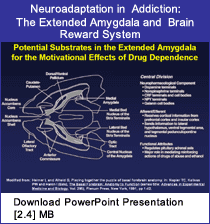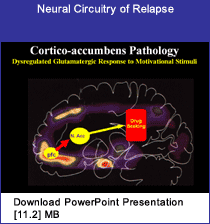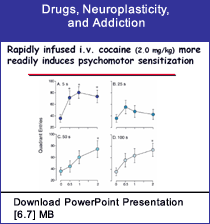Moving the Targets: The Neurobiology of Addiction
Neuroadaptation in Addiction: The Extended Amygdala and Brain Reward System
George F. Koob, Ph.D.
 SUMMARY: Dr. George Koob discussed the conceptual structure for drug addiction focused on allostatic changes in reward function that lead to excessive drug intake. He provided a heuristic framework with which to identify the neurobiologic and neuroadaptive mechanisms involved in the development of drug addiction. Koob reviewed the key elements of the brain reward system implicated in the development of addiction—activation of the extended amygdala and its connections; the dysregulation of specific neurochemical mechanisms (opioid peptides, gamma-aminobutyric acid, glutamate and dopamine); recruitment of brain stress systems (corticotropin-releasing factor and norepinephrine); and dysregulation of brain antistress systems (neuropeptide Y). The changes in the reward and stress systems are hypothesized to maintain hedonic stability in an allostatic state,
as opposed to a homeostatic state, and as such convey the vulnerability for development of dependence and relapse in addiction.
SUMMARY: Dr. George Koob discussed the conceptual structure for drug addiction focused on allostatic changes in reward function that lead to excessive drug intake. He provided a heuristic framework with which to identify the neurobiologic and neuroadaptive mechanisms involved in the development of drug addiction. Koob reviewed the key elements of the brain reward system implicated in the development of addiction—activation of the extended amygdala and its connections; the dysregulation of specific neurochemical mechanisms (opioid peptides, gamma-aminobutyric acid, glutamate and dopamine); recruitment of brain stress systems (corticotropin-releasing factor and norepinephrine); and dysregulation of brain antistress systems (neuropeptide Y). The changes in the reward and stress systems are hypothesized to maintain hedonic stability in an allostatic state,
as opposed to a homeostatic state, and as such convey the vulnerability for development of dependence and relapse in addiction.
|
Neural Circuitry of Relapse
Peter W. Kalivas, Ph.D.
 SUMMARY: Dr. Peter Kalivas described a neural circuitry mediating relapse model in rats trained to self-administer cocaine. Using microdialysis to examine changes in glutamate release, Kalivas discovered that the glutamatergic projection from the prefrontal cortex to the nucleus accumbens was a neural substrate shared between drug and stress primers, and that the increase resulted from alterations in presynaptic regulation of glutamate release caused by a deficit in cystine glutamate exchange. The reinstatement of drug seeking was abolished by reactivating the cystine-glutamate exchanger with a systemic injection of N-acetylcysteine, which is currently used clinically to restore glutathione levels.
SUMMARY: Dr. Peter Kalivas described a neural circuitry mediating relapse model in rats trained to self-administer cocaine. Using microdialysis to examine changes in glutamate release, Kalivas discovered that the glutamatergic projection from the prefrontal cortex to the nucleus accumbens was a neural substrate shared between drug and stress primers, and that the increase resulted from alterations in presynaptic regulation of glutamate release caused by a deficit in cystine glutamate exchange. The reinstatement of drug seeking was abolished by reactivating the cystine-glutamate exchanger with a systemic injection of N-acetylcysteine, which is currently used clinically to restore glutathione levels.
|
Drugs, Neuroplasticity, and Addiction
Terry E. Robinson, Ph.D.
 SUMMARY: Recent studies suggest that the transition from drug use to addiction is due in part to a drug-induced reorganization of brain systems involved in incentive motivational processes and those involved in decisionmaking and judgment that usually exert inhibitory control over behavior. Dr. Terry Robinson’s presentation focused on some of the long-term neurobehavioral consequences of repeated exposure to drugs of abuse, conditions that promote or retard drug-induced neuroplasticity, and the effects of drug-induced changes in mesolimbocortical circuitry for behavior and psychological function.
SUMMARY: Recent studies suggest that the transition from drug use to addiction is due in part to a drug-induced reorganization of brain systems involved in incentive motivational processes and those involved in decisionmaking and judgment that usually exert inhibitory control over behavior. Dr. Terry Robinson’s presentation focused on some of the long-term neurobehavioral consequences of repeated exposure to drugs of abuse, conditions that promote or retard drug-induced neuroplasticity, and the effects of drug-induced changes in mesolimbocortical circuitry for behavior and psychological function.
|
|
How Do Drugs of Abuse Rewire the Motivational Circuitry?
Marina E. Wolf, Ph.D.
 SUMMARY: During this presentation, Dr. Marina Wolf discussed her investigation of LTP-mediated neuronal plasticity. Her study focused on identifying mechanisms through which dopamine-releasing drugs can directly influence LTP, during which glutamate synapses are strengthened by phosphorylation of AMPA-type glutamate receptors and by insertion of new AMPA receptors into synapses. Using primary neuronal cultures prepared from nucleus accumbens or prefrontal cortex, her team showed that stimulation of D1 dopamine receptors produces rapid increases in AMPA receptor phosphorylation and externalization of AMPA receptors at extra-synaptic sites, which may promote LTP by increasing the AMPA receptor pool available for synaptic insertion.
SUMMARY: During this presentation, Dr. Marina Wolf discussed her investigation of LTP-mediated neuronal plasticity. Her study focused on identifying mechanisms through which dopamine-releasing drugs can directly influence LTP, during which glutamate synapses are strengthened by phosphorylation of AMPA-type glutamate receptors and by insertion of new AMPA receptors into synapses. Using primary neuronal cultures prepared from nucleus accumbens or prefrontal cortex, her team showed that stimulation of D1 dopamine receptors produces rapid increases in AMPA receptor phosphorylation and externalization of AMPA receptors at extra-synaptic sites, which may promote LTP by increasing the AMPA receptor pool available for synaptic insertion. |
|